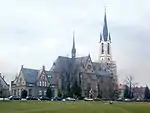Pieszyce
Pieszyce [pʲɛˈʂɨt͡sɛ] (German: Peterswaldau) is a town in Dzierżoniów County, Lower Silesian Voivodeship, in south-western Poland. It is the seat of the administrative district (gmina) Gmina Pieszyce.
Pieszyce | |
|---|---|
 Panorama of Pieszyce with the church of St. Anthony | |
 Coat of arms | |
 Pieszyce  Pieszyce | |
| Coordinates: 50°43′N 16°35′E | |
| Country | |
| Voivodeship | |
| County | Dzierżoniów |
| Gmina | Pieszyce |
| Town rights | 1962 |
| Government | |
| • Mayor | Dorota Konieczna-Enoezel |
| Area | |
| • Total | 17.72 km2 (6.84 sq mi) |
| Population (2019-06-30[1]) | |
| • Total | 7,123 |
| • Density | 400/km2 (1,000/sq mi) |
| Time zone | UTC+1 (CET) |
| • Summer (DST) | UTC+2 (CEST) |
| Area code(s) | +48 74 |
| License plates | DDZ |
| Website | http://www.um.pieszyce.pl |
Geography
It is situated in the historic Lower Silesia region on the northern slopes of the Owl Mountains, approximately 5 kilometres (3 mi) southwest of Dzierżoniów, and 56 kilometres (35 mi) southwest of the regional capital Wrocław.
As of 2019, the town has a population of 7,123.
History
The Waldhufendorf settlement in the Duchy of Silesia, one of the duchies of fragmented Poland, was first mentioned in a 1250 deed. The first church was built in the 13th century.[2] In 1291 it fell with the lands of Świdnica to the Silesian Duchy of Jawor, which upon the death of Duke Bolko II the Small in 1368 was ruled by the Kings of Bohemia.
From the 16th century onwards, Peterswaldau developed as a centre of weaving. The Lords of Perswaldau had a castle erected in 1617, which was rebuilt in a Baroque style in 1710. The Polish-Saxon cabinet minister Erdmann II of Promnitz acquired the estates in 1721 and gained the privilege to fabricate woven goods by Emperor Charles VI.
With most of Silesia, Peterswaldau was annexed from Habsburg-ruled Bohemia by Prussia after the First Silesian War in 1742. In 1765 the lordship passed to Count Christian Frederick of Stolberg-Wernigerode, whose descendants held the estates until their expulsion in 1945. The social hardship of the population in the course of the 19th century industrialisation was perpetuated by the famous Silesian author Gerhart Hauptmann in his play The Weavers, which is set in Peterswaldau. From 1871 the village was part of Germany and in 1945, after Nazi Germany's defeat in World War II, it became again part of Poland. It was granted town rights in 1962. From 1975 to 1998 Pieszyce was in Wałbrzych Voivodeship.
Sights
The most significant historic landmarks of the town are:[2]
- Pieszyce Castle complex
- Saint James church
- Saint Anthony church
 Pieszyce Castle
Pieszyce Castle Defensive walls of Pieszyce Castle
Defensive walls of Pieszyce Castle Saint James church
Saint James church Saint Anthony church
Saint Anthony church
Notable people
- Anna of Stolberg-Wernigerode (1819–1868), deaconess and matron of the Bethanien hospital in Berlin
Twin towns – sister cities
References
- "Population. Size and structure and vital statistics in Poland by territorial divison in 2019. As of 30th June". stat.gov.pl. Statistics Poland. 2019-10-15. Retrieved 2020-02-14.
- "Zabytki gminy Pieszyce". UM Pieszyce (in Polish). Retrieved August 12, 2019.
External links
- Jewish Community in Pieszyce on Virtual Shtetl